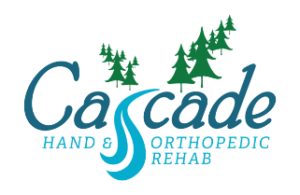Ergonomics for Hand Pain Prevention at Work

Do you leave the office with tingling in your fingers? Do you clock out from the job site rubbing out the pain in your hands? Hand pain is common among workers of all types, but the more you use your hands, the more likely you are to experience it. Fortunately, work ergonomics is a hand pain prevention solution–the experts at Cascade Hand & Orthopedic Rehab will show you how.
Ergonomics is a field of study focused on the interaction between people and their environment, including their working environment. By pulling from such diverse fields as anatomy and physiology, engineering, and psychology, ergonomics aims to improve worker comfort and productivity.
Hand discomfort is one area where ergonomics can shine. Many different jobs require workers to perform small, delicate hand motions over and over–think typing, operating hand tools, or picking up items. Over time, these simple movements can cause repetitive stress injuries in the wrists and hands, leading to pain, reduced range of motion, and more.
Our team of hand and occupational therapists can help you or your manager ensure an ergonomically-designed workstation that promotes healthy, happy hands. To learn more about Cascade Hand & Orthopedic Rehab role in work ergonomics and hand pain prevention, call us at our clinic today!
How Can Work Hurt My Hands?
The first step in improving workplace ergonomics is understanding your risk of workplace injury. Work, in general, tends to prevent us from moving naturally: some jobs require prolonged periods of sitting while others keep you locked in one location, performing the same motion repeatedly.
It’s that repetitive motion that’s most likely to cause hand pain. Most work-related hand pain is the result of an overuse injury. When most of us hear the word “injury,” we think of single, sudden traumas, like a broken bone. Overuse injuries, however, aren’t so dramatic. They result from several microtraumas that build up over time.
Most hand overuse injuries damage your hand’s soft tissue: its muscles, tendons, ligaments, and nerves. Injuries to the muscles, tendons, or ligaments cause pain and reduced range of motion. De Quervain syndrome, for example, will cause discomfort at the base of the thumb. Carpenters, office workers, and musicians all perform movements that can overuse the affected tendon.
Nerve injuries can also cause pain and limited range of motion, but you may also experience tingling and numbness. Carpal tunnel syndrome is one of the most notorious work-related nerve conditions. While we often associate it with typing and office work, manual laborers and service workers are actually more at risk: slicing food, using a cash register, and operating a chainsaw can all cause you to develop carpal tunnel syndrome.
If you are experiencing hand pain and work in a job requiring extensive use of your hands, our team of experts can help you understand exactly what’s causing your pain–and whether or not your job might be at fault.
The Role of Work Ergonomics in Hand Pain Prevention
If work is causing or aggravating your hand pain, you may wonder about your options. After all, most of us can’t simply quit our jobs! Fortunately, Cascade Hand & Orthopedic Rehab offers work ergonomics for hand pain prevention, meaning we can help you optimize your workspace to minimize pain and discomfort.
Workplace ergonomics begins with an evaluation of your workspace. Whether that’s a home office, a hair salon, a kitchen, or a construction site, our hand and occupational therapists can evaluate your environment and tools and provide suggestions for improvement:
- Office Workers: If you spend a lot of time on a computer, it’s crucial that you set up your mouse and keyboard to reduce strain on your hands and wrists. When typing, your elbows should be at a 90-degree angle (which means your keyboard probably needs to be lower than you think).
- Warehouse & Assembly Line Workers: If your job requires you to pick up items–whether heavy or bulky or small and delicate–it’s essential that you do so in a way that doesn’t strain your fingers. For example, handholds on boxes can help, as can using proper hand positions. We’ll show you how!
- Construction Workers, Landscapers, and Tradesman: Ergonomics is crucial if your job requires hand tools. Vibrating tools, such as jackhammers, can damage your hands, so using vibration-dampening gloves and equipment handles is vital to reduce your risk. For hand tools, make sure your tools fit comfortably in your hand, and use power tools (such as power screwdrivers) when possible.
- For Everyone: No matter your job, one easy way to protect your hands is by taking regular breaks! Adding in stretches or simple hand exercises can also help balance out the repetitive stress caused by your job. Our therapists will show personalized movements that will best address your needs.
Work Ergonomics Hand Pain Prevention: Get Started Today!
No matter what job you have, work ergonomics hand pain prevention is crucial. The team at Cascade Hand & Orthopedic Rehab is trained in assessing and improving the ergonomics of workplaces of all types, ensuring that you don’t suffer pain or impairment in your upper extremities.
To get started, request your appointment with us today!
